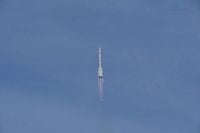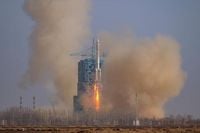China’s space program has faced its fair share of challenges, but few have tested its mettle quite like the emergency that unfolded aboard the Tiangong space station this November. In a rapid and coordinated response, China launched the unmanned Shenzhou-22 spacecraft on Tuesday, November 25, 2025, after a suspected space debris impact compromised the return capsule of the previous mission, Shenzhou-20, leaving the station’s crew temporarily stranded without a safe way home.
The drama began on November 5, when astronauts aboard Shenzhou-20 were preparing to return to Earth after a six-month stint on Tiangong. Just hours before their planned departure, minor cracks were discovered in a window of their spacecraft’s descent module, damage attributed to a possible collision with orbital debris. According to SpaceNews, this discovery triggered an immediate emergency response from the China Manned Space Agency (CMSA), which ultimately postponed the crew’s return and upended the station’s carefully choreographed operations.
With their own vehicle deemed unsafe for reentry, the Shenzhou-20 crew—Chen Dong, Chen Zhongrui, and Wang Jie—were forced to remain on the station longer than planned. The situation grew more complicated as Tiangong, which typically supports three astronauts, now had to accommodate six for an additional nine days. Supplies, already stretched, became a growing concern.
CMSA made the call: the Shenzhou-20 crew would return to Earth aboard the newly arrived Shenzhou-21 spacecraft, which had delivered the next team—Zhang Lu, Wu Fei, and Zhang Hongzhang—on October 31. On November 14, after a record 204 days in orbit, the Shenzhou-20 crew touched down in Inner Mongolia, while the Shenzhou-21 astronauts were left aboard Tiangong without a lifeboat. For over ten days, they had no safe means of evacuation in case of emergency—a nerve-wracking scenario for any space agency.
Enter Shenzhou-22. Originally scheduled for a crewed flight in April or May 2026, the mission was rapidly repurposed and readied for launch in record time. As reported by Chinese state broadcaster CCTV and confirmed by the China Aerospace Science and Technology Corporation (CASC), the normal test-to-launch cycle of more than 30 days was compressed to just 16 days. Zeng Yaoxiang, an engineer at CASC, told CCTV, “The whole period from tests to launch is 16 days, which is a very short window. It requires full concentration and strict adherence to the plan, and uncompromising quality control.”
At 04:11 UTC on November 25, a Long March-2F rocket thundered off the pad at the Jiuquan Satellite Launch Center in Inner Mongolia, carrying the 8,100 kg Shenzhou-22 spacecraft. The launch, conducted in a southeasterly direction, inserted the vehicle into an orbit inclined 41.47 degrees to the equator, perfectly matching Tiangong’s own path 386 by 391 km above Earth.
Just three and a half hours later, at 07:50 UTC, Shenzhou-22 docked autonomously with the forward port of Tiangong’s Tianhe core module. The arrival marked the end of a tense 20-day emergency response and restored a lifeboat capability for the Shenzhou-21 crew. According to the China Manned Space Agency, the three astronauts were “working normally and in good condition” as of the day before the launch—a testament to their professionalism and the agency’s crisis management.
Unlike previous missions, Shenzhou-22 carried no humans; instead, its cargo bay was packed with food, fruit, vegetables, and clothing to replenish supplies consumed during the extended stay of the Shenzhou-20 crew. The spacecraft also featured several upgrades, including an improved human–machine interface, a miniaturized instrument panel, an optimized return-capsule layout, and increased down-mass capability. Notably, it carried a device designed to treat the cracks in Shenzhou-20’s window, raising hopes that the damaged vehicle might still be salvaged for an uncrewed return to Earth or further experiments.
This mission was not only a technical feat but also a first in China’s human spaceflight history: the first emergency “launch-on-need” flight. As NASA Spaceflight points out, such contingency launches have a long pedigree, dating back to the Skylab and Space Shuttle eras, and more recently with Russia’s Soyuz MS-23 mission after a similar incident on the International Space Station. China’s rapid mobilization demonstrates that it has learned from the experiences of other spacefaring nations and is committed to the safety of its astronauts, or “taikonauts.”
Still, the episode left some observers with lingering questions. For a period of 11 days, the Shenzhou-21 crew had no backup vehicle docked—a gap in lifeboat coverage that, while ultimately managed, highlights the ever-present danger of space debris in low Earth orbit. The CMSA’s longstanding policy is to keep the next Shenzhou spacecraft and its Long March-2F rocket in a state of near-readiness at Jiuquan, a “one launch, one on standby” approach. The timely launch of Shenzhou-22 seems to validate this policy, but as SpaceNews notes, the next backup, Shenzhou-23, is still being assembled in Beijing with no announced delivery date to the launch site.
Looking ahead, the Shenzhou-21 crew—Zhang Lu, Wu Fei, and Zhang Hongzhang—are now about a month into their six-month stint aboard Tiangong. They are expected to return to Earth aboard Shenzhou-22 around April or May 2026. In the meantime, Shenzhou-20 remains docked to the station, awaiting its fate. It may be returned uncrewed to China, or, if deemed too risky, disposed of over the Pacific.
China’s ambitions for Tiangong remain undiminished. The country plans to keep the station operational and permanently crewed for at least a decade, with expansion plans already underway. In a symbolic move, China has signed an agreement with Pakistan to send the first foreign astronaut to Tiangong, aiming to open its doors to international partners even as it remains excluded from the International Space Station since 2011.
For now, the successful launch and docking of Shenzhou-22 serve as a powerful reminder of the risks inherent in human spaceflight—and of the ingenuity, determination, and adaptability required to overcome them. China’s space program, with its eyes on the stars and feet firmly on the ground, has proven once again that it’s ready to meet the unexpected, whatever form it may take.


